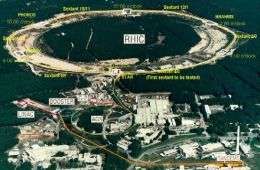November 21, 2008 feature
The Relativistic Heavy Ion Collider Makes Some Noise

(PhysOrg.com) -- A group of physicists studying heavy-ion collisions at the Relativistic Heavy Ion Collider (RHIC), a large particle accelerator located on Long Island, New York, recently showed that the collisions can create acoustic shock waves -- sonic booms. This new information could be used to learn even more about the intriguing state of matter produced during the collisions.
The matter, known as a quark-gluon plasma, is produced because the collisions are so energetic and hot that the ions' constituent particles, quarks and gluons -- known collectively as partons -- which are normally tightly bound together, "melt" into a fluid-like particle soup.
"What does a quark gluon plasma sound like? We wanted to find out," said Duke University physicist Bryon Neufeld to PhysOrg.com, the paper's corresponding author. "Sound waves are commonly used as a probe of everyday matter. But sound may also be a useful tool for researching matter at temperatures many thousands of times hotter than the sun.
"Our work addresses the question of sound from a different perspective: What is the sound generated by highly energetic particles moving through the quark-gluon plasma, and how can we use it to explore the properties of the plasma?"
Neufeld co-authored the paper on this research, appearing in the October 13 edition of Physical Review C, with physicists Berndt Mueller (Duke University) and Jorg Ruppert (McGill University, Montreal, Canada and J. W. Goethe-Universitat, Frankfurt, Germany).
The group was looking for evidence of a Mach cone -- the cone-shaped shock wave caused by the pressure difference created when an object, like an airplane or particle, exceeds the speed of sound in that particular medium (the speed of sound is different in different media).
Said Neufeld, "Highly energetic particles traveling faster than the speed of sound may produce characteristic sound patterns, such as Mach cones, which create distinctive experimental signatures. These experimental signatures can help determine certain characteristics of the medium they are traveling through, such as the speed of sound and viscosity."
After the heavy-ion beams collide (in this case the beams consisted of either gold or lead nuclei), some partons back-scatter into the plasma rather than out of it. The physicists modeled the case of a single parton moving through the plasma, depositing energy and momentum in its wake. They took that model and used it to solve the hydrodynamic equations of the plasma. The solutions show that, mathematically, if the parton is moving faster than the speed of sound in the plasma a Mach cone trails behind it.
Citation: Phys. Rev. C 78, 041901 (2008)
Copyright 2008 PhysOrg.com.
All rights reserved. This material may not be published, broadcast, rewritten or redistributed in whole or part without the express written permission of PhysOrg.com.





















